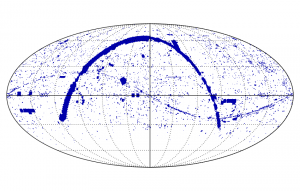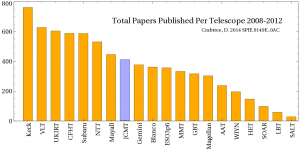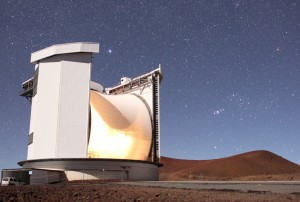With a diameter of 15m the James Clerk Maxwell Telescope (JCMT) is the largest astronomical telescope in the world designed specifically to operate in the submillimetre wavelength region of the spectrum. The JCMT is located near the summit ridge of Maunakea at an altitude of 4092m.
Contents
What makes the JCMT unique?
For a full description of the telescope please click here.
Unlike optical and infrared telescopes that use detectors (eg. cameras) that are, these days, manufactured en-masse and with uniform sensitivity, the instrumentation at JCMT is individualistic and customized, and therefore challenging to design and build. Our latest, fully commissioned instrument (operating since 2011) is SCUBA-2 – a 10,000 pixel camera – that can detect the faint signature of cool, distant objects – such as comets and planets, star forming clouds and galaxies.
Having a single dish, and large field of view, means that the JCMT has the ability to map vast regions of the sky relatively quickly. The JCMT is often used to identify objects and regions of interest that other telescopes – such as the SMA and ALMA, with higher resolution but smaller field of view – can subsequently observe in greater detail. This is similar to having a magnifying glass as opposed to a microscope – both are useful at seeing the beauty of nature, but they work at different size scales!

Areas of the sky observed by SCUBA-2 on the JCMT. This includes Survey fields and public data (as of 2014).
If you have ever seen images of the JCMT you will have noticed the iconic Gore-Tex ® membrane that is situated in front of the dish. This enables the JCMT to potentially operate 24 hours a day. In practice, this is limited by sky stability (the afternoons on Maunakea are often cloudy or the atmosphere turbulent), and by more mundane constraints such as the need for regular engineering maintenance. JCMT is not limited by the (optical) brightness of the daytime sky, but more by the amount of water vapor in the atmosphere – which emits submillimetre radiation and makes the sky ‘bright’ in the submillimetre. (On the other hand – we can observe very well through icy (cirrus) clouds while optical and infrared telescopes can see nothing!)
How productive is the JCMT?
The JCMT is extremely productive. Scientists rate telescope “productivity” in terms of the number of scientific papers published that relied on the telescope.

Total number of published papers per telescope. It should be noted that HST published 3721 papers – not shown on the graph . Crabtree, D. 2014 SPIE.9149E..0AC.
Productivity might also be judged by how many astronomers submit proposals to use the telescope. The proposals are then assessed by a panel of experts to ensure the telescope is used for the best possible research. In the most recent “Call for Proposals” the JCMT was oversubscribed by a factor of 5!
What science does the JCMT do?
All sorts! We observe
- comets – helping to understand the origin of Earth’s water
- planets – most notably looking at the atmosphere of Venus during the Venus Transit (incredibly our telescope can look directly at the Sun!)
- stars – expanding shells around old (super)giant stars seed the interstellar medium with dust particles and molecules that are processed in subsequent epochs of star- & planet-formation.
- interstellar clouds of gas and dust – where that star- and planet-formation occurs – to help understand how our own planet and solar system were formed
- galaxies – both nearby and far, far away . . . representing snapshots of the Universe at different epochs – which allow us to study the evolution of galaxies, and of the Universe as a whole!
For more details about the science that the JCMT undertakes please click here.
Why is JCMT located on Maunakea?
At submillimetre wavelengths a lot of the radiation coming from space is absorbed, and then re-emitted, by the water in Earth’s atmosphere. It’s a double-whammy! The brightness of the object we’re trying to measure is reduced, and the background (‘sky’) brightness is increased; this makes submillimetre astronomy doubly difficult! The summit of Maunakea typically sits above the local wet atmosphere, and is one of the few, superb locations in the world for this branch of astronomy.
- In recognition of the privilege of being able to carry out our science in the area of Maunakea designated as the astronomy precinct managed by the University of Hawaii, an annual allotment of observing time is made to the University.
What does the future hold for the JCMT?
Under the new ownership of the East Asian Observatory, two new instruments are currently being tested and commissioned by science staff; potential visiting instrumentation has been identified by partner countries; and new high impact instrumentation has been proposed to replace the current receivers. These developments will keep the JCMT at the forefront of astronomical research. Much new astronomical knowledge is still to be discovered by JCMT




